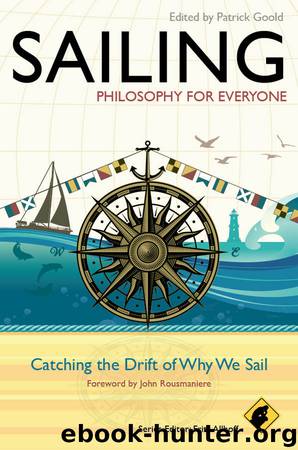Sailing--Philosophy For Everyone by Fritz Allhoff

Author:Fritz Allhoff
Language: eng
Format: epub
Publisher: Wiley
Published: 2012-05-04T04:00:00+00:00
PART 3
BEAUTY AND OTHER AESTHETIC ASPECTS OF THE SAILING EXPERIENCE
NICHOLAS HAYES
CHAPTER 8
WHAT THE RACE TO MACKINAC MEANS
Seen from the International Space Station through the night sky, the most conspicuous patch of ink-black darkness in the lower United States is the 22,400 square surface miles of Lake Michigan. Lake Superior is larger, but its edges are less defined by electric light, because fewer people live around it. Lake Michigan appears to hang from Canada like a smooth dollop of cool, dark honey from the edge of a jar. If we use this contrast to consider the human condition, we quickly conclude that we hug the shores and seem never to breach them. But, during a few nights every July, the night population on Lake Michigan surges from none to about one person for every seven square miles, in an apparent rush to be off-grid. It is not enough to pierce the sky, but the surface is specked with red, green, and white navigation lights that can only be seen by sailors.
The occasion is a race from Chicago to Mackinac Island, in which about three thousand sailors on about three hundred sailboats cross a starting line near Chicago and use wind to travel three hundred miles north-by-northeast.
To a casual observer watching the sailors prepare their boats, the harbor might seem like a circus grounds; on one end, shimmering stars and starlets in perfect painted luxury porta-homes served by bright-white uniformed entourages; on the other, the hardy, hardened, pockmarked tractor-trailer drivers doing double duty as midway amusement attendees. In the middle, the observer finds an American microcosm: moms and grandmothers, teachers and taxi drivers, frat-boys and fullbacks, cat-lovers and Cubs-fans, sojourners and sportsmen, eggheads and environmentalists, rookies and retirees. One might conclude that sailing can appeal to anyone but that it self-selects: the boats appear to reflect the people and the people seem to reflect the boats.
There are boats that seem like “passenger trains,” designed for long work. Engines (sails) will overcome friction and weight to move the train (a boat) down the track (the course) at a relatively predictable speed. Passenger trains can be designed for different duties: some like city work, some like the long haul, some favor volume over comfort, and some favor comfort over speed. The locomotive can be made more efficient or designed to pull more weight, and the cars can be made sleeker or more posh. There are old trains and new ones. Some are brightly painted, others utilitarian. But, architecturally speaking, passenger trains don’t differ from each other significantly in form or function. Timing and execution are what separate the good from the bad. Running a passenger train well requires that it is well-known by its engineer, well-serviced by its mechanic, and well-timed by its conductor, and that it keeps moving all along its route. Then, it might reach its destination faster than another passenger train.
There are the “Model Ts.” Not Model T, as in old and square, but Model T as in all the same, or one design – Henry Ford’s central idea.
Download
This site does not store any files on its server. We only index and link to content provided by other sites. Please contact the content providers to delete copyright contents if any and email us, we'll remove relevant links or contents immediately.
| Anthropology | Archaeology |
| Philosophy | Politics & Government |
| Social Sciences | Sociology |
| Women's Studies |
The remains of the day by Kazuo Ishiguro(8410)
Tools of Titans by Timothy Ferriss(7824)
Giovanni's Room by James Baldwin(6820)
The Black Swan by Nassim Nicholas Taleb(6782)
Inner Engineering: A Yogi's Guide to Joy by Sadhguru(6446)
The Way of Zen by Alan W. Watts(6292)
Asking the Right Questions: A Guide to Critical Thinking by M. Neil Browne & Stuart M. Keeley(5360)
The Power of Now: A Guide to Spiritual Enlightenment by Eckhart Tolle(5346)
The Six Wives Of Henry VIII (WOMEN IN HISTORY) by Fraser Antonia(5242)
Astrophysics for People in a Hurry by Neil DeGrasse Tyson(5004)
12 Rules for Life by Jordan B. Peterson(4166)
Housekeeping by Marilynne Robinson(4070)
The Ethical Slut by Janet W. Hardy(4042)
Skin in the Game by Nassim Nicholas Taleb(3978)
Double Down (Diary of a Wimpy Kid Book 11) by Jeff Kinney(3935)
Ikigai by Héctor García & Francesc Miralles(3900)
The Art of Happiness by The Dalai Lama(3851)
Skin in the Game: Hidden Asymmetries in Daily Life by Nassim Nicholas Taleb(3736)
Walking by Henry David Thoreau(3685)
